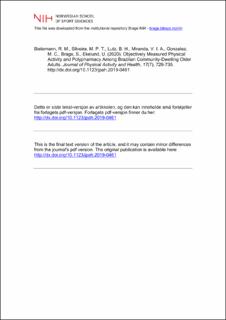| dc.contributor.author | Bielemann, Renata M. | |
| dc.contributor.author | Silveira, Marysabel P. T. | |
| dc.contributor.author | Lutz, Bárbara H. | |
| dc.contributor.author | Miranda, Vanessa I. A. | |
| dc.contributor.author | Gonzalez, Maria Cristina | |
| dc.contributor.author | Brage, Soren | |
| dc.contributor.author | Ekelund, Ulf | |
| dc.contributor.author | Bertoldi, Andréa D. | |
| dc.date.accessioned | 2021-04-28T08:38:46Z | |
| dc.date.available | 2021-04-28T08:38:46Z | |
| dc.date.created | 2021-01-29T14:59:36Z | |
| dc.date.issued | 2020 | |
| dc.identifier.citation | Journal of Physical Activity and Health. 2020, 17(7), 729-735. | en_US |
| dc.identifier.issn | 1543-3080 | |
| dc.identifier.uri | https://hdl.handle.net/11250/2740079 | |
| dc.description | I Brage finner du siste tekst-versjon av artikkelen, og den kan inneholde ubetydelige forskjeller fra forlagets pdf-versjon. Forlagets pdf-versjon finner du på www.humankinetics.com / In Brage you'll find the final text version of the article, and it may contain insignificant differences from the journal's pdf version. The original publication is available at www.humankinetics.com | en_US |
| dc.description.abstract | Background: Previous observations regarding association between physical activity (PA) and use of medicines among older adults are derived from self-reported PA. This study aimed to evaluate the association between objectively measured PA and polypharmacy among older adults with multimorbidity in Southern Brazil. Methods: This study included 875 noninstitutionalized older people, aged ≥60 years. Prescribed medicines used in the 15 days prior to the interview, socioeconomic data, and the presence of comorbidities were self-reported. Accelerometers were used to evaluate PA following the interview. Results: Prevalence of polypharmacy (≥5 medicines) was 38.3% (95% confidence interval, 35.0–41.5); those belonging to the lowest tertile of PA used more medicines. The authors observed a significant inverse association for polypharmacy between men belonging to the second and third tertiles of PA for objectively measured overall PA and light PA compared with the most inactive tertile. For women, the association between PA and polypharmacy was significant for overall, light, and moderate to vigorous PA only in the third tertile. Conclusions: Overall, light and moderate to vigorous PA were inversely associated to polypharmacy and differed by gender. Promotion of PA in older adults may be an effective intervention to reduce the number of medicines used independent of the number of comorbidities. | en_US |
| dc.language.iso | eng | en_US |
| dc.subject | accelerometry | en_US |
| dc.subject | aging | en_US |
| dc.subject | epidemiology | en_US |
| dc.subject | gerontology | en_US |
| dc.title | Objectively Measured Physical Activity and Polypharmacy Among Brazilian Community-Dwelling Older Adults | en_US |
| dc.type | Peer reviewed | en_US |
| dc.type | Journal article | en_US |
| dc.description.version | acceptedVersion | en_US |
| dc.source.pagenumber | 729-735 | en_US |
| dc.source.volume | 17 | en_US |
| dc.source.journal | Journal of Physical Activity and Health | en_US |
| dc.source.issue | 7 | en_US |
| dc.identifier.doi | 10.1123/jpah.2019-0461 | |
| dc.identifier.cristin | 1882654 | |
| dc.description.localcode | Institutt for idrettsmedisinske fag / Department of Sports Medicine | en_US |
| cristin.ispublished | true | |
| cristin.fulltext | postprint | |
| cristin.qualitycode | 1 | |
